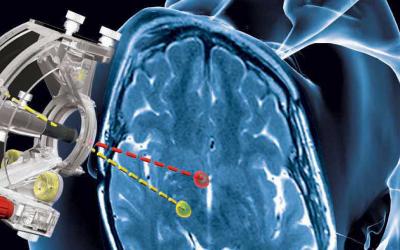
Interventional MRI (iMRI)-Guided Stereotaxy
This is a completely novel method for performing MRI-guided stereotactic surgery that was first developed by Drs. Starr, Martin and Larson at UCSF for DBS implantation in 2003. At that time, traditional surgery for DBS required an awake patient and involved physiologic mapping, which resulted in multiple brain penetrations, longer procedures times and discomfort for some patients. Our group devised a new stereotactic technique to place DBS electrodes using real-time MRI imaging, with the entire procedure performed within the bore of a 1.5 or 3T MRI scanner. MRI-guided DBS has several advantages over traditional DBS implantation; surgery is performed under general anesthesia with a single brain penetration and no physiologic mapping, surgical time is reduced to less than 50% of awake procedures, and real-time imaging during surgery allows for immediate detection of complications.
In 2007, we collaborated with MRI Interventions to develop a second-generation system known as ClearPoint. The system consists of a skull mounted stereotactic platform and a software environment that allows iMRI-guided stereotaxy to be performed in any MRI scanner. ClearPoint was approved by the FDA in late 2010. It is now being used in over 50 centers in the US for DBS, laser ablation and drug delivery, however we remain the most experienced center in iMRI-guided stereotaxy in the world.
Our lab is using ClearPoint as the delivery platform of choice for our gene therapy research programs, and we continue to conduct clinical research in MRI-guided DBS for movement disorders. We have also collaborated with others at UCSF using this technique for basic science and clinical research in drug delivery, cell transplantation and laser ablation (Drs. Bankiewicz, Gupta, Aghi, Lim and Auguste).
Key Team Members and Collaborators
Philip Starr, MD, PhD
Alastair Martin, PhD
Doris Wang, MD, PhD
Jill Ostrem, MD
Krys Bankiewicz, MD, PhD
Sarah Wang, PhD
Related Publications
Starr PA, Martin AJ, Ostrem JL, Talke P, Levesque N, Larson PS. Subthalamic nucleus deep brain stimulator placement using high field interventional magnetic resonance imaging and a skull-mounted aiming device: technique and application accuracy. J Neurosurg 112(3):479-90, Mar 2010. PMID: 19681683
Richardson RM, Kells AP, Martin AJ, Larson PS, Starr PA, Piferi PG, Bates G, Tansey L, Rosenbluth KH, Bringas JR, Berger MS, Bankiewicz KS. Novel platform for MRI-guided convection-enhanced delivery of therapeutics: preclinical validation in nonhuman primate brain. Stereotact Funct Neurosurg 89(3):141-51, 2011. Epub 14 Apr 2011. PMID: 21494065
Larson PS, Starr PA, Bates G, Tansey L, Richardson RM, Martin AJ. An optimized system for interventional MRI guided stereotactic surgery: preliminary evaluation of targeting accuracy. Neurosurgery 70(1 Suppl Operative):95-103, Mar 2012. PMID: 21796000
Ostrem JL, Galifianakis NB, Markun LC, Grace JK, Martin AJ, Starr PA, Larson PS. Clinical outcomes of PD patients having bilateral STN DBS using high-field interventional MR-imaging for lead placement. Clin Neurol Neurosurg 115(6):708-12, 2013. Epub 1 Sep 2012. PMID: 22944465
Silvestrini MT, Yin D, Martin AJ, Coppes VG, Mann P, Larson PS, Starr PA, Zeng X, Gupta N, Panter SS, Desai TA, Lim DA. Interventional magnetic resonance imaging-guided cell transplantation into the brain with radially branched deployment. Mol Ther 23(1):119-29, 2015. Epub 20 Aug 2014. PMID: 25138755
Ostrem JL, Ziman N, Galifianakis N, Starr PA, San Luciano M, Katz M, Racine CA, Martin AJ, Markun LC, Larson PS. Clinical outcomes using ClearPoint interventional MRI for DBS lead placement in Parkinson’s disease. J Neurosurg 124(4):908-16, 2016. Epub 23 Oct 2015. PMID: 26495947

